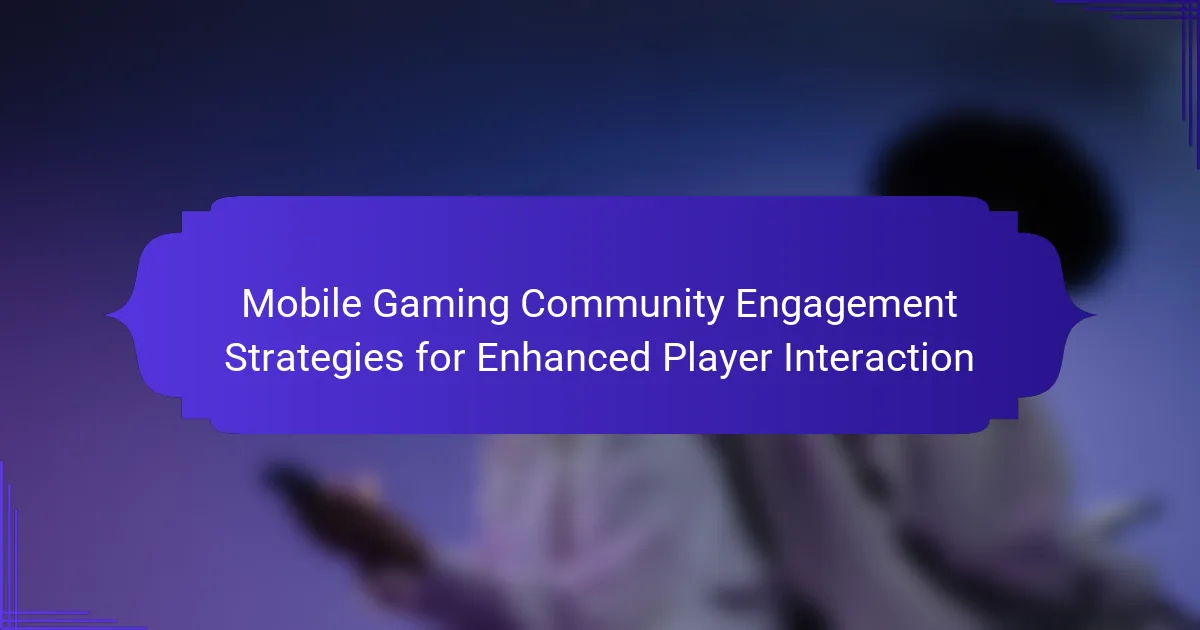Enhancing player interaction in mobile gaming is crucial for retention and satisfaction. Key strategies include implementing social features, providing regular updates, and organising community events. Understanding regional preferences and player demographics can tailor engagement efforts effectively. Additionally, leveraging user-generated content and utilising social media fosters a vibrant gaming community.
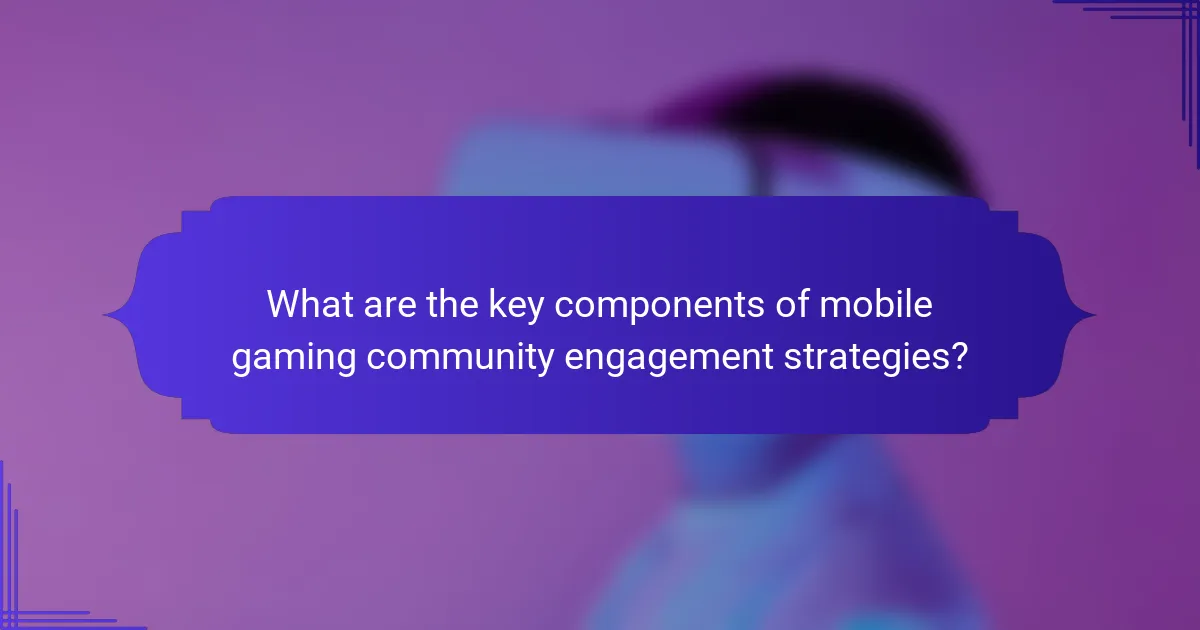
What are the key components of mobile gaming community engagement strategies?
Mobile gaming community engagement strategies focus on fostering player interaction through various components. Key components include social features, regular updates, community events, and feedback mechanisms.
Social features enhance connectivity by allowing players to form friendships and teams. Regular updates keep the content fresh and players invested. Community events create excitement and encourage participation. Feedback mechanisms enable players to voice their opinions, fostering a sense of ownership.
These strategies collectively improve player retention and satisfaction, driving a vibrant gaming community.
How do social media platforms enhance player interaction?
Social media platforms enhance player interaction by fostering community engagement and facilitating real-time communication. They provide channels for players to share experiences, form connections, and participate in discussions. Features like live streaming, in-game events, and user-generated content boost interaction. Players can join groups or forums, enhancing collaboration and competition. Additionally, social media analytics help developers understand player preferences, leading to tailored experiences. This creates a vibrant ecosystem where players feel valued and connected.
Which communication tools foster community building?
Mobile gaming communities thrive through tools that enhance interaction and collaboration. Key communication tools include Discord, which offers voice and text channels, fostering real-time engagement. Forums like Reddit allow for in-depth discussions and community feedback. Social media platforms, such as Facebook and Twitter, enable players to share experiences and updates. In-game chat features promote immediate communication during gameplay, enhancing teamwork. Finally, streaming platforms like Twitch create opportunities for community bonding through shared viewing experiences. Each tool contributes uniquely to building a vibrant mobile gaming community.
What role do in-game events play in player engagement?
In-game events significantly enhance player engagement by creating excitement and fostering community interaction. These events encourage players to participate actively, often introducing limited-time challenges or rewards that boost motivation.
Events like tournaments or seasonal celebrations promote competition and collaboration, drawing players back into the game. The unique attributes of these events, such as exclusive items or achievements, further incentivise participation.
As a result, mobile gaming communities thrive, with players forming connections and sharing experiences during these events. This dynamic interaction leads to increased retention rates and a more vibrant gaming environment.
How can developers leverage user-generated content?
Developers can leverage user-generated content by encouraging player participation and fostering community interaction. This approach enhances engagement and builds loyalty. For example, integrating player feedback into game updates can create a sense of ownership among users. Additionally, hosting contests for user-generated content, such as artwork or gameplay videos, can drive creativity and strengthen community bonds. Engaging with players on social media platforms allows developers to showcase this content, further promoting community involvement.
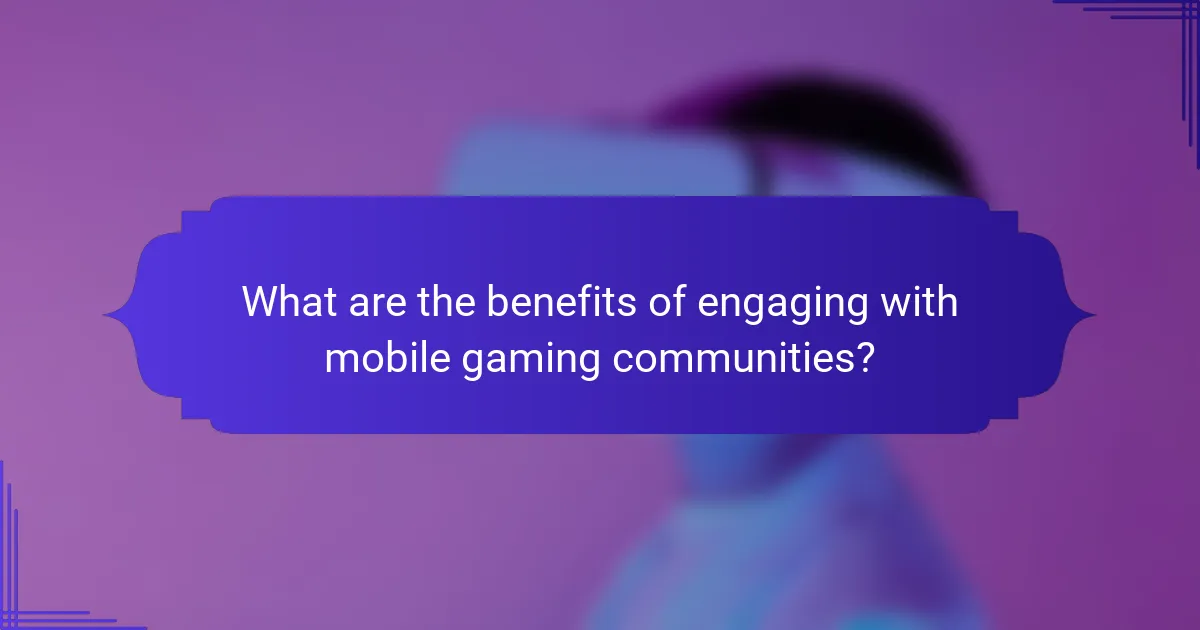
What are the benefits of engaging with mobile gaming communities?
Engaging with mobile gaming communities enhances player interaction by fostering connections, sharing knowledge, and building loyalty. These communities provide support, facilitate in-game coordination, and create a sense of belonging. Players benefit from shared strategies, tips, and exclusive content, leading to improved gameplay experiences. As a result, active participation often translates to increased retention rates and player satisfaction.
How does community engagement influence player retention?
Community engagement significantly enhances player retention by fostering a sense of belonging. Players are more likely to stay engaged when they feel connected to a community. Active forums, social media interactions, and in-game events create opportunities for players to share experiences and build relationships.
Moreover, feedback loops established through community engagement enable developers to tailor content according to player preferences, increasing satisfaction. For instance, games that incorporate player suggestions often see higher retention rates.
In addition, community-driven events and challenges encourage participation, making gameplay more enjoyable and rewarding. Players who participate in these activities develop loyalty, further solidifying their commitment to the game.
Ultimately, effective community engagement strategies lead to improved player interaction and retention, creating a vibrant ecosystem around mobile gaming.
What impact does player feedback have on game development?
Player feedback significantly influences game development by shaping design decisions and enhancing player satisfaction. Developers analyse player input to identify areas for improvement, ensuring games align with community expectations. This engagement fosters a sense of ownership among players, leading to increased loyalty and retention. Regular updates based on feedback can also enhance gameplay experiences, making players feel valued and heard. Ultimately, integrating player feedback creates a more dynamic and responsive game environment.
Which engagement strategies lead to increased monetization?
Engagement strategies that enhance player interaction in mobile gaming can significantly boost monetization. Effective community engagement fosters loyalty, increases in-game purchases, and drives user retention.
1. Regular updates and events create excitement and keep players returning.
2. User-generated content encourages creativity and investment in the game.
3. Social media interaction builds a sense of community and connection.
4. Personalised communication enhances player experience and satisfaction.
5. Incentives for engagement, such as rewards for participation, motivate players to interact more.
Implementing these strategies can lead to a more vibrant gaming community and improved revenue streams.
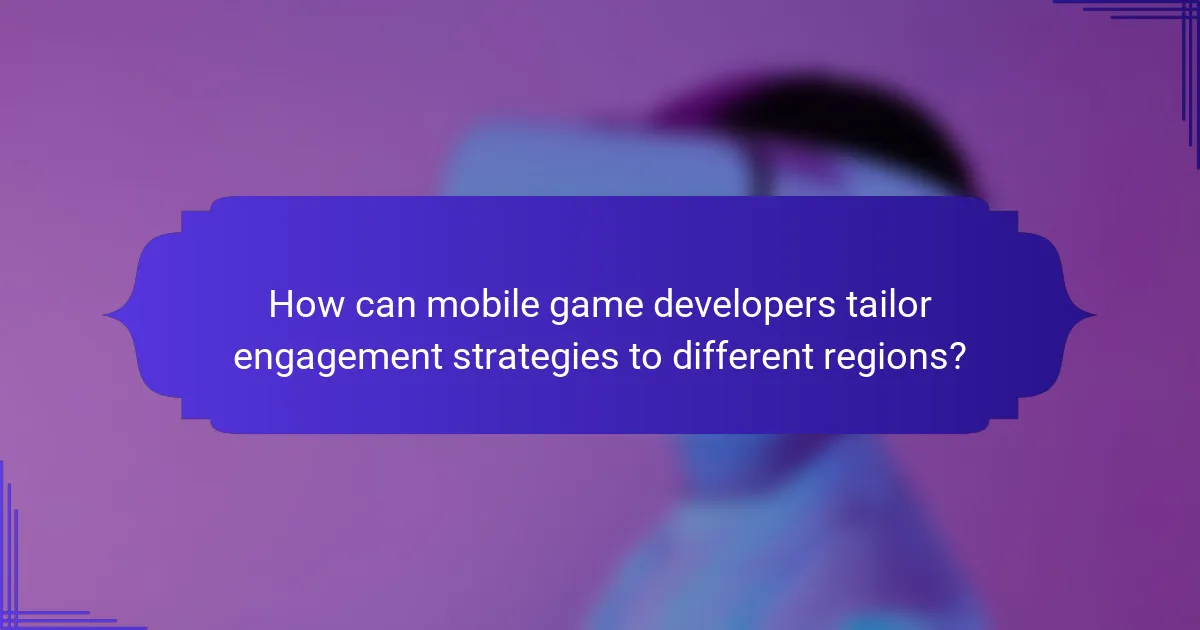
How can mobile game developers tailor engagement strategies to different regions?
Mobile game developers can enhance player interaction by customising engagement strategies to regional preferences. Understanding cultural nuances, local gaming trends, and communication styles is essential for effective engagement.
Developers should analyse regional player demographics, including age, interests, and gaming habits. For instance, younger audiences may prefer fast-paced games, while older players might enjoy strategy-based titles. Tailoring content and marketing strategies to fit these preferences can significantly boost engagement.
In addition, incorporating local languages and cultural references into games fosters a sense of community. This approach not only makes the game more relatable but also encourages players to connect with one another, enhancing overall interaction.
Finally, leveraging regional events and holidays for in-game promotions can drive engagement. By aligning game updates with local festivities, developers can create timely content that resonates with players, increasing their connection to the game.
What cultural factors should be considered in community engagement?
Cultural factors in community engagement include understanding local values, communication styles, and social norms. Respect for cultural diversity enhances player interaction and fosters a sense of belonging. Engaging with community leaders and influencers can also strengthen relationships and trust within the gaming community. Recognising unique cultural events or traditions can create opportunities for tailored engagement strategies that resonate with players.
How do player preferences vary across different demographics?
Player preferences in mobile gaming differ significantly across demographics. Age, gender, and cultural background influence game selection, engagement styles, and social interactions.
Younger players often prefer fast-paced, competitive games, while older demographics may favour strategy or casual games. Gender differences show that females are more inclined toward social or narrative-driven games, whereas males often engage with action or sports genres. Cultural background also shapes gaming preferences, with certain regions favouring specific game mechanics or themes.
Understanding these variations helps developers tailor engagement strategies. By analysing demographic data, developers can enhance player interaction through targeted content, community features, and personalised experiences.
Which engagement strategies are most effective in specific regions?
Mobile gaming community engagement strategies vary in effectiveness across regions. Tailored approaches enhance player interaction significantly.
In North America, social media integration fosters community building. In Europe, local events and tournaments drive engagement. Asia benefits from mobile-first strategies, emphasising in-game events and collaborations with influencers. Latin America thrives on community-driven content, leveraging user-generated media. Africa sees success with mobile accessibility initiatives, enhancing participation.
Understanding regional preferences allows developers to implement effective engagement strategies.
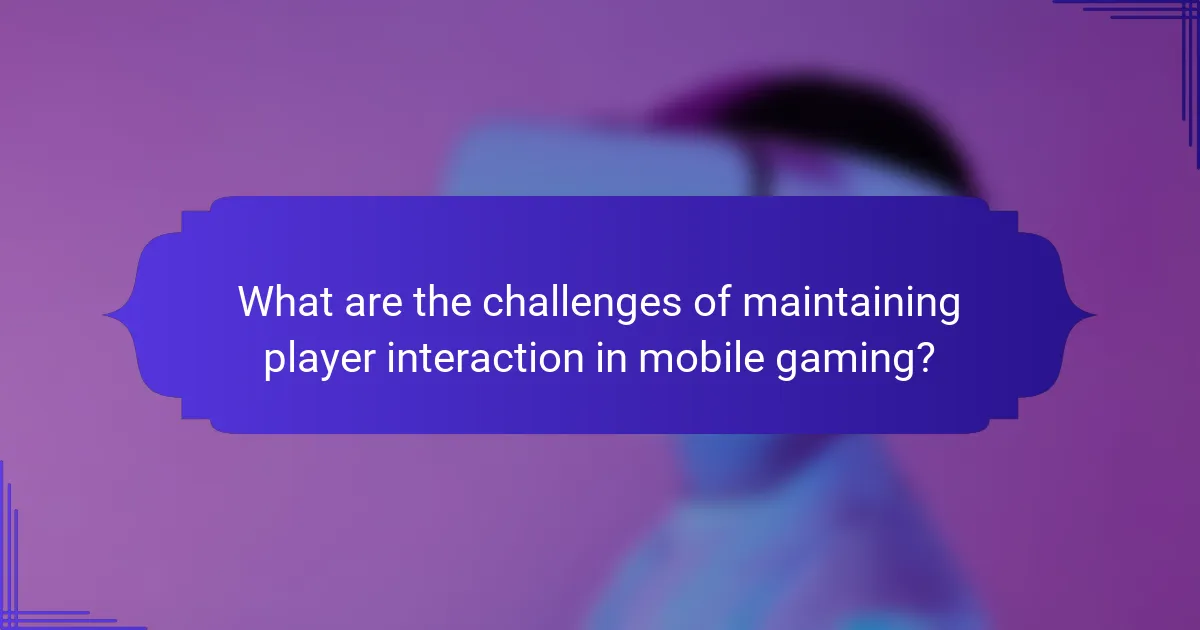
What are the challenges of maintaining player interaction in mobile gaming?
Maintaining player interaction in mobile gaming faces multiple challenges. Key issues include competition from other games, player retention, and evolving player expectations.
Competition from a vast array of mobile games makes it difficult to capture and maintain player attention. Players often switch games based on trends, leading to high churn rates.
Player retention is crucial yet challenging. Engaging players consistently requires regular updates, new content, and effective communication strategies.
Evolving player expectations demand innovative features and seamless experiences. Gamers increasingly seek personalised interactions and community engagement, pushing developers to adapt rapidly.
How do developers address toxicity in gaming communities?
Developers address toxicity in gaming communities through proactive moderation, community guidelines, and player education. They implement reporting systems that allow players to flag toxic behaviour, which helps maintain a positive environment. Regular updates to community standards ensure that players understand acceptable behaviour. Additionally, developers promote inclusivity through events and initiatives that celebrate diversity, fostering a sense of belonging among players. Engaging with the community through feedback surveys also helps developers identify and address specific issues related to toxicity effectively.
What are the common pitfalls in community management?
Common pitfalls in community management include neglecting player feedback, failing to foster inclusivity, and lacking consistent communication. These issues can lead to disengagement and a fractured community. Additionally, ignoring analytics can prevent understanding player behaviour and preferences, hindering effective strategies. Prioritising short-term goals over long-term community health often results in unsustainable engagement.
How can developers measure engagement effectiveness?
Developers can measure engagement effectiveness through metrics like retention rates, session length, and player feedback. Analysing these metrics reveals how well players interact with the game and community. Retention rates indicate how many players return after their first session, while session length shows the time spent in-game. Player feedback through surveys or forums provides qualitative insights into user satisfaction. Combining these data points helps developers refine strategies for enhanced player interaction.
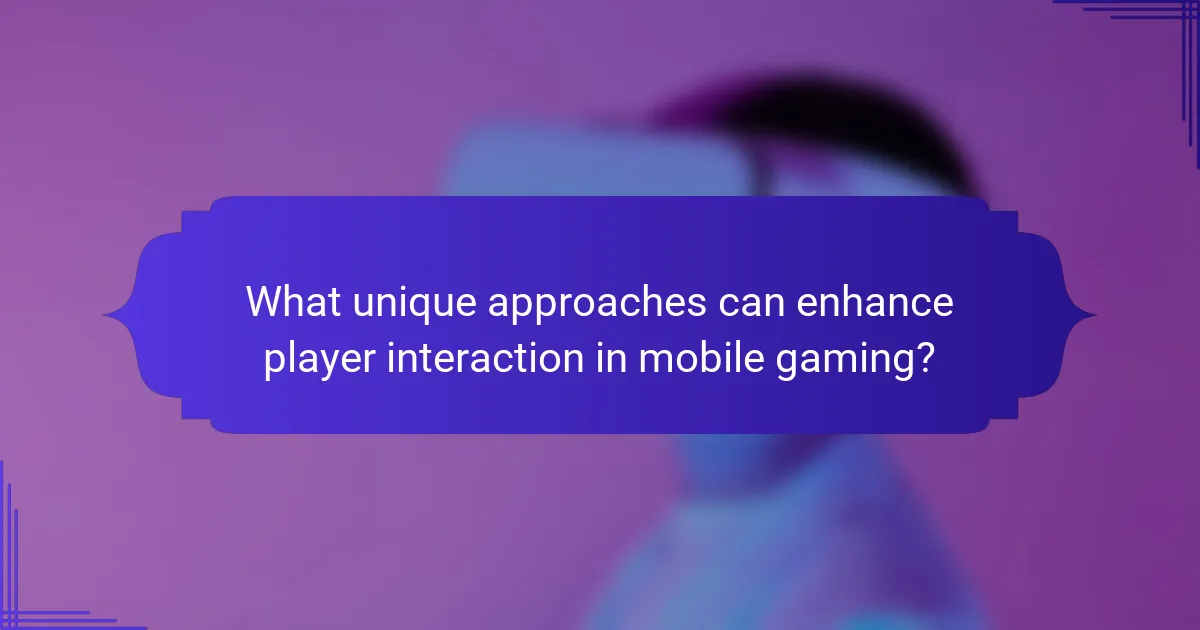
What unique approaches can enhance player interaction in mobile gaming?
To enhance player interaction in mobile gaming, unique approaches include personalised experiences, community-driven events, and innovative in-game mechanics. Personalised experiences, such as tailored content and rewards, foster deeper engagement. Community-driven events, like tournaments and collaborative challenges, create a sense of belonging. Innovative in-game mechanics, such as real-time feedback and interactive storytelling, keep players invested and motivated. These strategies leverage social interaction and player agency to build vibrant gaming communities.
How do loyalty programs and rewards systems impact community engagement?
Loyalty programs and rewards systems significantly enhance community engagement by incentivising player participation. These programs create a sense of belonging among players, encouraging them to interact more frequently.
By offering rewards such as exclusive in-game items or discounts, developers can foster deeper connections within the community. Increased player interaction often leads to higher retention rates, as players feel valued and recognised for their loyalty.
Moreover, successful loyalty programs can lead to user-generated content, where players share their experiences and achievements, further amplifying community engagement. This organic promotion enhances the overall gaming experience and attracts new players.
In summary, loyalty programs and rewards systems are effective tools for boosting community engagement in mobile gaming, driving player interaction, retention, and content creation.
What innovative technologies can be utilized for player interaction?
Innovative technologies for player interaction include augmented reality, virtual reality, and real-time chat features. These technologies enhance engagement by creating immersive experiences and fostering community connections. Augmented reality overlays digital elements onto the real world, while virtual reality offers fully immersive environments. Real-time chat facilitates instant communication, allowing players to connect and collaborate effectively. Additionally, gamification elements, such as rewards and achievements, can further motivate players to engage with the community.
How can cross-platform play enhance community dynamics?
Cross-platform play enhances community dynamics by fostering inclusivity and broadening player interaction. Players across different platforms can engage together, creating a larger, more diverse community. This collaboration encourages social connections, shared experiences, and collective achievements. Enhanced communication tools and community events can further strengthen these bonds, leading to increased player retention and satisfaction. Ultimately, cross-platform play cultivates a vibrant gaming environment that attracts and retains players, driving ongoing engagement.
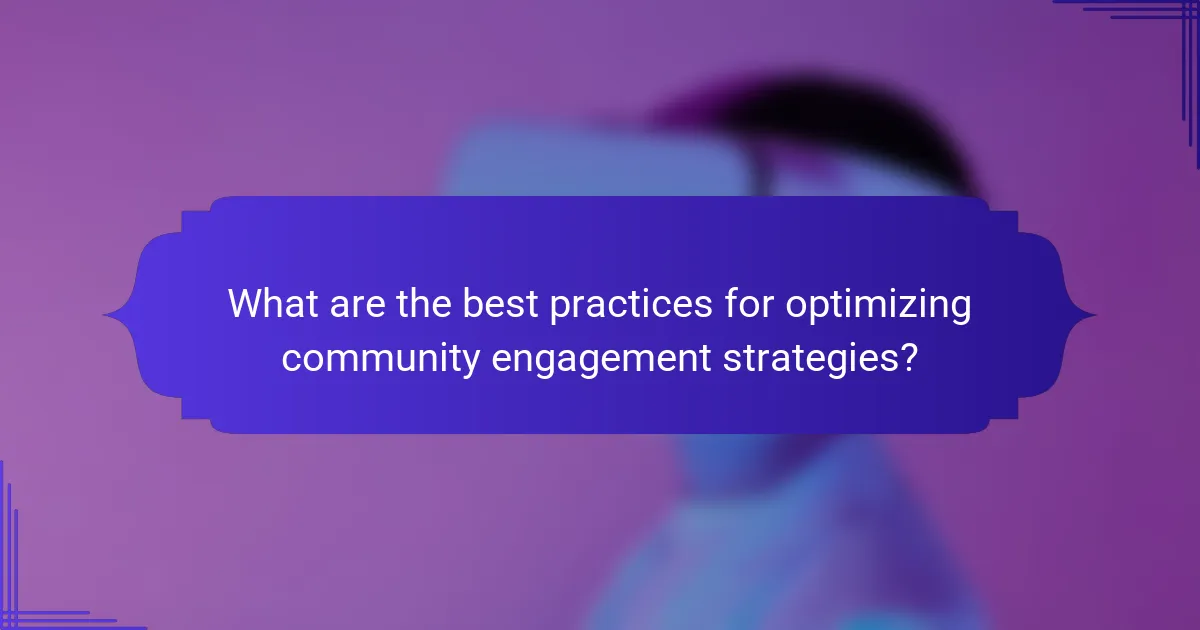
What are the best practices for optimizing community engagement strategies?
To optimize community engagement strategies in mobile gaming, focus on fostering interaction through personalised experiences, regular feedback loops, and community-driven events.
Encourage user-generated content to enhance player involvement and establish a sense of ownership. Utilise social media platforms to create discussions and share updates, ensuring players feel connected and valued. Implement in-game events that promote collaboration and competition, fostering a vibrant community atmosphere.
Regularly analyse engagement metrics to refine strategies, ensuring they align with player preferences and behaviours. Prioritise transparency and communication to build trust and loyalty within the community.
How can developers create a welcoming environment for new players?
Developers can create a welcoming environment for new players by fostering community engagement and support. Key strategies include implementing onboarding tutorials, creating inclusive forums, and organising regular community events.
Onboarding tutorials help new players understand game mechanics and features, enhancing their initial experience. Inclusive forums allow players to share experiences and ask questions, promoting interaction. Regular community events encourage participation and strengthen connections among players, creating a sense of belonging.
These strategies collectively enhance player interaction and retention, ultimately leading to a more robust gaming community.
What strategies can be employed to keep the community active over time?
To keep a mobile gaming community active over time, implement regular events, foster player feedback, and encourage social interaction. Engaging players through competitions and seasonal updates maintains interest.
1. Host regular in-game events to create excitement and participation.
2. Actively seek player feedback to improve the gaming experience.
3. Establish community forums or social media groups for interaction.
4. Reward consistent players with exclusive content or recognition.
5. Create challenges that promote collaboration among players.
Which metrics should be monitored to assess engagement success?
To assess engagement success in mobile gaming communities, monitor metrics such as active users, session duration, player retention rate, social interactions, and feedback scores. These metrics provide insights into player behaviour and community vitality.
| Metric | Description |
|—————————-|—————————————————|
| Active Users | Number of unique players engaging within a timeframe |
| Session Duration | Average time spent in-game per player |
| Player Retention Rate | Percentage of players returning after initial play |
| Social Interactions | Frequency of comments, shares, and in-game chats |
| Feedback Scores | Ratings and reviews reflecting player satisfaction |
What common mistakes should be avoided in community engagement?
To enhance community engagement, avoid common mistakes such as neglecting player feedback, failing to create inclusive environments, and ignoring effective communication channels. Prioritise consistent interaction to build trust and foster loyalty. Ensure that players feel valued by recognising their contributions and addressing concerns promptly.
